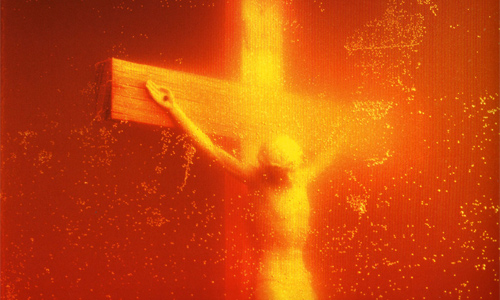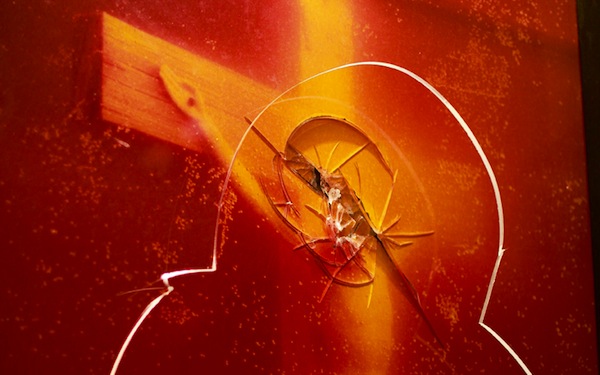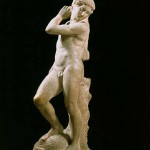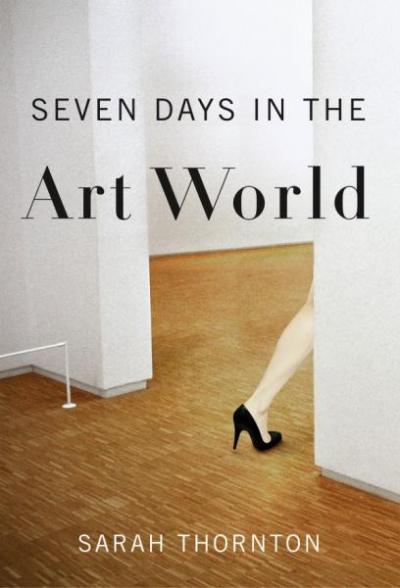The culture wars are back. And they seem to have a corporate sponsor that sells fried chicken sandwiches. With the Presidential election looming the political pundits are active, as are the Reformed and evangelical bloggers, girding themselves for battle, urging their minions not to retreat and fight for traditional middle American values in the face of those liberals on the coasts.
The absurdity of this situation, in which the starting point for a discussion of cultural engagement is a Chick-fil-A drive-through, makes me yearn for the good old days of the 1990s when art was believed (rightly) to threaten the stability of American culture and its traditional values, and defunding the National Endowment of the Arts in order to promote a pro-American art occupied the efforts of our leading political conservatives. The icon of the culture wars in the 1990s was Andres Serrano’s Piss Christ.
Serrano received about $10,000 from the NEA in the late 1980s to help defray a fraction of the costs to make two series of photographs, of which Piss Christ was one work in one of the two series, which used kitchy Christian and Classical statuettes photographed through plexi-glas containers filled with urine, supposedly the artist’s own.
Serrano’s work has been characterized by the creation of stunningly beautiful images from the most repugnant and tabooed subjects, such as cadavers, mutilated animals, excrement, and even high ranking members of the Ku Klux Klan. From the beginning, politicians and commentators bore false witness against Piss Christ, using words and phrases like “a Crucifix submerged in a jar of urine” and other reductive phrases to give the impression that the work was simply a juvenile gesture of desecration. The tension that the work produces comes not from the work alone but from the title, which clues the viewer into the source of its overwhelming luminosity, generating an unexpected but undeniable space where beauty and ugliness, power and weakness, glory and humiliation embrace.
But that space was destroyed by the culture wars. The rough and reductionist discourse on both the Left and Right had an effect on Serrano himself. In early interviews, Serrano talked about the challenges growing up gay within the context of the Roman Catholic Church and spoke sensitively and insightfully of the ambivalence of Piss Christ, revealing that it was a work that came from his own conflicted emotions and complex experiences. Yet as the culture warriors on both the Left and Right used this image, Serrano fell increasingly in line with the radical (and adolescent) liberal art world response, and he became much less interested in maintaining that evocatively ambivalent space opened up by that photograph itself. Serrano became more anti-religious, the work becoming more provocative and antagonistic than it had appeared to him years earlier. And he went on the lecture circuit, harping against the Christian Right on college campuses. Deprived of the space his work created by the culture war, Serrano became the agitator, the anti-religious provocateur.
Piss Christ continues, decades later, to be the subject of iconoclastic violence, bred from its use and abuse as an icon of the culture wars. In April 2011, in Avignon, France, four young men attacked it. The space that Piss Christ generated, which exceeded even the scope of Serrano’s conflicted and ambivalent intensions, was generated by grace. But that space is long gone, a victim of the culture wars.
Grace is God’s final word to humanity in desperate need of being forgiven. Grace is what is preached in Word and Sacrament. It is grace that characterizes the witness of the Church to the nations. A primary responsibility of the cultural theologian is to discern the operation of grace in the world, an operation of an alien presence that is in the process of overturning the regime of law, of tit-for-tat, karma, and quid pro quo. And it is often found in art, literature, and music—precisely those endeavors that can undermine the world’s legal framework of justification, that saturates our lives and shapes our institutions.
A cultural theologian should be characterized, following Luther, as a Theologian of the Cross. It is not in triumph, success, strength, beauty, and power, which seduce the Theologian of Glory, that we find Christ in this world, but in failure, taboo, cultural excrement, marginalization, and humiliation.
Iconoclasm, the destruction of images, is a testimony to their power. But the power of Piss Christ is in the space it creates where grace operates, even beyond the intentions of the artist and those who would use the work as a weapon in the culture war. The chief victim in the culture wars is grace. Neither side could tolerate its presence in Piss Christ, that it could bear witness to something even Serrano, his defenders, and opponents, were unable to recognize fully—the inescapable beauty of the cross, borne from hatred, ugliness, and violence, a beauty that comes out of ugliness and an ugliness that never lets the viewer deny the beauty.
Grace rarely makes the news, strengthens a political platform, or wins an argument. In the culture wars, whether in the art gallery or the fast food drive-through, it is grace that is the victim. But it is grace that is God’s last word, the Word in Christ who forgives and who is in the process of making all things new, not by law but by grace. And if we listen, we just might be able to see it at work in the world.
Sola gratia













